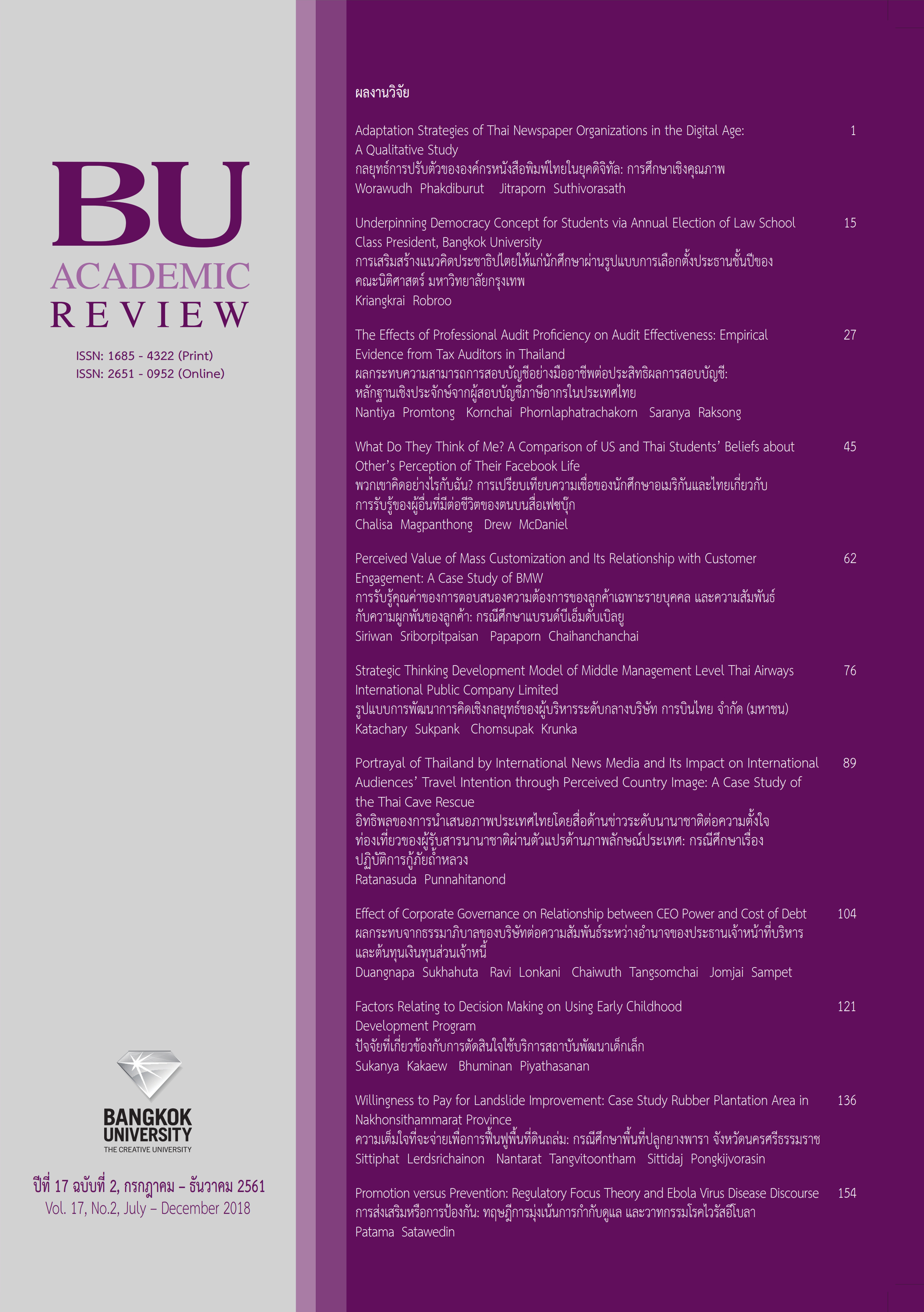อิทธิพลของการนำเสนอภาพประเทศไทยโดยสื่อด้านข่าวระดับนานาชาติต่อความตั้งใจท่องเที่ยวของผู้รับสารนานาชาติผ่านตัวแปรด้านภาพลักษณ์ประเทศ: กรณีศึกษาเรื่องปฏิบัติการกู้ภัยถ้ำหลวง กรณีศึกษา เรื่องปฏิบัติการกู้ภัยถ้ำหลวง
Main Article Content
บทคัดย่อ
การนำเสนอข่าวเกี่ยวกับประเทศไทยของสื่อด้านข่าวระดับนานาชาติส่วนใหญ่มักเกี่ยวข้องประเด็นเชิงลบ เช่น โรคภูมิคุ้มกันบกพร่อง (เอดส์) โสเภณี และมลภาวะ ความสำเร็จของปฏิบัติการกู้ภัยช่วยเหลือเด็กชาย 12 คนพร้อมผู้ฝึกสอนฟุตบอลที่สูญหายไปในถ้ำหลวง จ.เชียงราย ซึ่งเป็นหนึ่งในจังหวัดภาคเหนือของประเทศไทย กลายเป็นเรื่องที่ผู้คนทั่วโลกต่างเฝ้าดูด้วยใจจดจ่อ การวิจัยนี้ใช้แบบจำลองสี่มิติของภาพลักษณ์ประเทศเป็นกรอบแนวคิด โดยมีวัตถุประสงค์เพื่อศึกษาภาพลักษณ์โดยรวมของประเทศไทยที่นำเสนอโดยสื่อด้านข่าวระดับนานาชาติ และเพื่อศึกษาว่าอิทธิพลของการเปิดรับการนำเสนอข่าวเรื่องปฏิบัติการกู้ภัยถ้ำหลวงของผู้รับสารส่งผลทางอ้อมต่อความตั้งใจท่องเที่ยวประเทศไทยผ่านตัวแปรด้านภาพลักษณ์ประเทศหรือไม่ เพื่อตอบคำถามวิจัยทั้งสองข้อนี้ ผู้วิจัยใช้วิธีวิจัยแบบผสม คือ การวิเคราะห์ตัวบท และการวิจัยเชิงสำรวจ
ในส่วนของการวิเคราะห์ตัวบท ผู้วิจัยเจาะจงเลือกข่าวออนไลน์จำนวน 50 ข่าวจากสื่อด้านข่าวระดับนานาชาติ 5 สำนัก ได้แก่ ซีเอ็นเอ็น บีบีซี อัลจาซีรา นิวส์ดอทคอมดอทเอยู และแชนแนลนิวส์เอเชีย ที่ได้รับการเผยแพร่ระหว่างวันที่ 23 มิถุนายนถึง 20 สิงหาคม 2561 มาทำการวิเคราะห์ตัวบทในประเด็นของการนำเสนอภาพโดยสื่อ เพื่อค้นหาแนวคิดหลักด้านภาพลักษณ์ของประเทศไทย เมื่อใช้การวิเคราะห์ข้อมูลเชิงเปรียบเทียบอย่างต่อเนื่องของ Strauss และ Corbin (1990) พบว่า สื่อด้านข่าวระดับนานาชาตินำเสนอภาพของประเทศไทยออกมาเป็น 5 ลักษณะ ได้แก่ การดำเนินงานที่มีประสิทธิภาพ ความสามารถอันน่าประทับใจ คุณภาพเชิงสุนทรีย์ คุณธรรมตามหลักพุทธศาสนา และคุณลักษณะของบุคคลอันน่าทึ่ง
ในส่วนของการวิจัยเชิงสำรวจ ผู้วิจัยศึกษากลุ่มตัวอย่างที่เป็นชาวต่างชาติจำนวน 369 คน เพื่อทดสอบสมมติฐานการวิจัย ผลการวิเคราะห์การถดถอยพหุคูณแบบลำดับขั้น บ่งชี้ว่าการเปิดรับข่าวเรื่องปฏิบัติการกู้ภัยถ้ำหลวงของผู้รับสารนานาชาติส่งผลอย่างมีนัยสำคัญทางสถิติต่อองค์ประกอบด้านความคิดของภาพลักษณ์ประเทศ ซึ่งองค์ประกอบนี้ส่งผลต่อองค์ประกอบด้านอารมณ์ ซึ่งส่งผลต่อไปยังความตั้งใจท่องเที่ยวประเทศไทย ผลการวิจัยนี้ไม่เพียงแต่มีนัยสำคัญเชิงวิชาการด้านการสื่อสาร แต่มีนัยสำคัญเชิงบริหารจัดการแก่หน่วยงานภาครัฐที่กำกับดูแลภาพลักษณ์ประเทศและการส่งเสริมการท่องเที่ยว เช่น กระทรวงการต่างประเทศ และการท่องเที่ยวแห่งประเทศไทย
Article Details
บทความที่นำมาสมัครลงตีพิมพ์ในวารสารต้องไม่เคยได้รับการตีพิมพ์เผยแพร่มาก่อน และไม่ส่งต้นฉบับบทความซ้ำซ้อนกับวารสารอื่น รวมทั้งผู้เขียนบทความต้องไม่ละเมิดหรือคัดลอกผลงานของผู้อื่น
เอกสารอ้างอิง
Avraham, E. (2000). Cities and their news media images. Cities, 17(5), 363 – 370. DOI:10.1016/S0264-2751(00)00032-9.
BBC. (2018). Retrieved from https://www.bbc.com/news/world/asia
BBC. (2018). The full story of Thailand’s extraordinary cave rescue. Retrieved from https://www.bbc.com/news/world-asia-44791998
Brewer, P. R., Graf, J., & Willnat, L. (2003). Priming or framing media influence on attitudes toward foreign countries. Gazette, 65(6), 493 – 508. Retrieved July
3, 2012 from https://ics-www.leeds.ac.uk/papers/pmt/exhibits/1813/mediaforeign.pdf.
Buhmann, A., & Ingenhoff, D. (2015a). Advancing the country image construct from a public relations perspective: From
model to measurement. Journal of Communication Management, 19(1), 62 – 80.
Buhmann, A., & Ingenhoff, D. (2015b). The 4D model of the country image: An integrative approach from the perspective of communication management. The
International Communication Gazette, 77(1), 102-124.
Blume, B. (2018). Rebranding Thailand in a dark cave. Facebook: Burton on Branding. Retrieved July 23, 2018 from
https://www.facebook.com/454480918305661/posts/rebranding-thailand-in-a-dark-cave-by-burton-blumeyou-may-not-realize-it-but-tha/
95215210898898/
Channel News Asia. (2018). Retrieved from https://www.channelnewsasia.com/news/asia
CNN. (2018). Retrieved from https://edition.cnn.com/world
Cozort, D., & Shields, J. M. (2018). Handbook of Buddhist ethics. Oxford: Oxford University Press.
de Beer, A. S. (2010). News from and in the “dark continent”: Afro-pessimism, news flows, global journalism and media regimes. Journalism Studies, 11(4),
596-609. Retrieved March 17, 2012. DOI: 10.1080/14616701003638509.
DeFleur, M. L., & Plax, T. G. (1980). Human communication as a biosocial process. International Communication Association Conference.
Dimitrova, D., & Strömbäck, J. (2005). Mission accomplished? Framing of the Iraq war in the elite newspapers in Sweden and the United States. Gasette,
67(5), 399 – 417. Retrieved July 3, 2012. DOI: 10.1177/0016549205056050.
Dimitrova, D. V., & Connolly-Ahern, C. (2007). A tale of two wars: Framing analysis of online news sites in coalition countries and the Arab world during the
Iraq war. Howard Journal of Communications, 18(2), 153 – 168. Retrieved April 3, 2012. DOI: 10.1080/10646170701309973.
Fan, Y. (2006). Banding the nation: What is being branded? Journal of Vacation Marketing, 12(1), 5 – 14.
Hagos, A. (2000). Hardened images: The Western media and the marginalization of Africa. Trenton, NJ: Africa World Press, Inc.
Hofstede, G. (1991). Cultures and organizations: Software of the mind. London: McGraw-Hill.
Jenes, B., & Simon, J. (2017). Measuring country image and country brand: Theory and practice. Abstract for the Doctoral Seminar of the 1st European
Marketing Academy (EMAC) Regional Conference. Retrieved August 5, 2018 from https://www.efos.unios.hr/makromarketing/wp.../ measuring_
country_image-seminar.pdf
Jenes, B. (2007). Connection between the ecologically oriented consumer behaviour and country image. Marketing and Management, 6, 34 - 43.
Kotler, P., Haider, D., & Rein, I. (1993). Marketing places: Attracting investment and tourism to cities, states and nations. The Free Press, 141.
Maher, A. A., & Carter, L. L. (2011). The affective and cognitive components of country image: Perceptions of American products in Kuwait. International
Marketing Review, 28(6), 559 – 580. DOI: 10.1108/02651331111181411.
Martin, I. M., & Eroglu, S. (1993). Measuring a multi-dimensional construct: Country image. Journal of Business Research, 28, 193. DOI: 10.1016/0148-
2963(93)90047-S
News.com.au. (2018). Retrieved from https://www.news.com.au/world/asia
Nuttavuthisit, K. (2007). Branding Thailand: Correcting the negative image of sex tourism. Place Branding and Public Diplomacy, 3(1), 21 – 30. Retrieved
August 12, 2018 from https://link.springer.com/article/10.1057/palgrave.pb.6000045
Papadopoulos, N., Heslop, L.A., & Berács, J. (1990). National stereotypes and product evaluations in a socialist country. International Marketing Review, 7(1),
32-46.
Rittichainuwat, B. N., Qu, H., & Brown, T. J. (2001). Thailand's international travel image: Mostly favorable. Cornell Hotel and Restaurant Administration
Quarterly, 42(2), 82 – 95.
Roth, K. P., & Diamantopoulos, A. (2009). Advancing the country image construct. Journal of Business Research, 62, 726-740.
Strauss, A., & Corbin, J. (1990). Basics of qualitative research: Grounded Theory procedures and techniques. Newbury Park: Sage.


